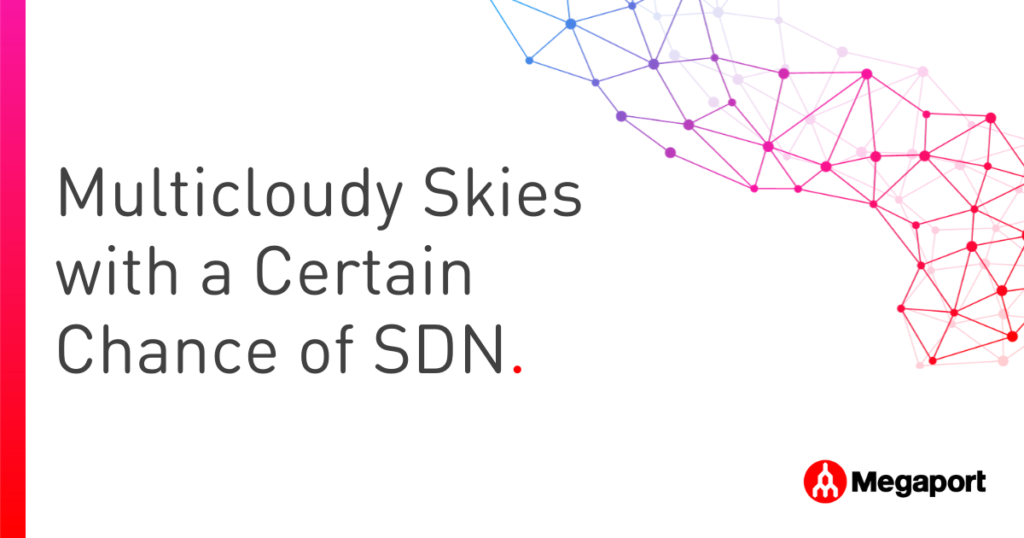
Multicloudy Skies with a Certain Chance of SDN
- Cloud networking , News
- December 20, 2019
- RSS Feed
Explore how multicloud connectivity reshapes enterprise strategies in 2020, enabling scalable, flexible, and resilient solutions. From seamless cross-cloud integration and managing the 'data deluge' to leveraging SDN for instant data center connections, discover trends driving smarter cloud adoption.
This article is authored by Megaport’s VP of Engineering and Product, John Veizades, and originally published on VMBlog.
In recent years, there’s been a lot of hype around “Multicloud Connectivity” and what it means for businesses. Enterprises have struggled to understand where multicloud fits into their ever-evolving business strategies. In 2018, many customers went all-in with one cloud. This began shifting in 2019, and we expect 2020 to be a breakout year for greater multicloud adoption.
Enterprises Increasingly Turn to Multicloud
In 2020, more enterprises than ever before will embrace multicloud for their business-critical applications. They will hedge their bets by having the same application available from several cloud providers. They will place a premium on the ability to switch among these different clouds both quickly and efficiently. While in previous years, many enterprises went all-in with a single cloud vendor, they no longer want to be beholden to one cloud vendor. Organisations of all sizes are committing to multicloud, while they expect the user experience to feel seamless across clouds.
Data Deluge Tests Cloud Connectivity
Enterprises have been warned about the coming “data deluge” for the past 15+ years, with industry pundits annually increasing the potential data volumes as technological advances, like AI, create new demands for greater amounts of data that were previously unimaginable. Like a closet in a spare bedroom, clouds offer convenient places for data. This will test cloud connectivity in 2020, as enterprises look for the best ways to access, manage and derive intelligence out of their data in the cloud. Next year, look for signs of a rising level of data reaching “mega tsunami” proportions, and enterprises laser-focusing on scalable cloud connectivity to harness this data.
Blame it on the Gig Economy
As consumers, we want what we want when we want it, without unnecessary waste. When we work at enterprises, we don’t leave our consumer mindset at the door. A trend that should increase in 2020 is continued demand for alternatives to “old-school” vendor lock-in, long-term networking contracts. As business needs change, network availability must be flexible and change with them. Cost reduction by paying only for what is needed and used. These trends aren’t new, but they’re spreading to more vertical industries as technology makes it possible for organisations of all sizes to get what they want when they want it at a price that they are willing to pay.
No More “Versus” Between On-Prem and Cloud
Companies in sectors that deal with high volumes of critical, sensitive data have traditionally felt the need to keep control and ownership of that data. In 2020, there will continue to be a need for industries like media and entertainment or financial services to maintain control and ownership of critical data by keeping it on-prem instead of in the cloud, while still executing compute on that data using cloud resources. This will mean that the tie between on-prem data and cloud compute will become increasingly more important, along with the latency of that connection, as lower latency is allowing companies to gather better insights on more data. In 2020, we’ll see a need to get data centres closer from a latency perspective to cloud resources, as this will become more valuable to customers than ever.
Software-Defined Networking Will Change the Game for Data Centres
Technology has accelerated our expectations about the speed of business. We expect nearly everything to happen “instantly,” and that includes the time required to connect to data centres. In previous years, connecting to a data centre was measured in days. In 2019, enterprise-to-data centre and data centre-to-data centre connections happen in minutes. Software-defined networks (SDNs) are changing the data centre experience for many organisations. We believe 2020 will be a step closer to the point where no human intervention is needed in data centres to connect customers to the data sources they need. Some may see this as lost jobs. We see this as freeing up time to do something more productive.


